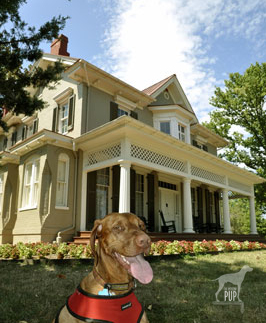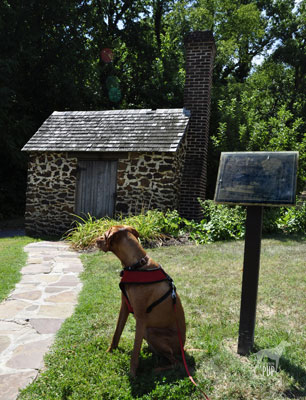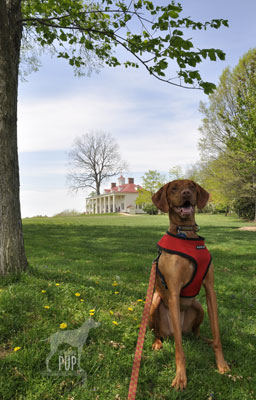 February is Black History Month, and the Intrepid Pup wants to share a true gem of the National Park Service: the Frederick Douglass National Historic Site. The house, known as Cedar Hill for the preponderance of cedar trees on the 9.75 acres, was the residence of an aging Frederick Douglass from 1877 until his death in 1895. This handsome estate in southeast Washington, DC’s Anacostia neighborhood sits atop a promontory commanding a truly magnificent panorama of the capital city and is a site tourists should venture beyond the National Mall to see.
February is Black History Month, and the Intrepid Pup wants to share a true gem of the National Park Service: the Frederick Douglass National Historic Site. The house, known as Cedar Hill for the preponderance of cedar trees on the 9.75 acres, was the residence of an aging Frederick Douglass from 1877 until his death in 1895. This handsome estate in southeast Washington, DC’s Anacostia neighborhood sits atop a promontory commanding a truly magnificent panorama of the capital city and is a site tourists should venture beyond the National Mall to see.
For those only familiar with Douglass (c. 1818 – 1895) from his 1845 autobiography Narrative of the Life of Frederick Douglass, An American Slave, Written by Himself, a visit to Cedar Hill takes the longer view, providing a more comprehensive treatment of Douglass’s life and legacy. A 17-minute introductory video, “Fighter for Freedom,” in the adjacent National Park Service visitor center chronicles Douglass’s childhood in slavery in Maryland and eventual escape to New York, marriage to free black Anne Murray, rise as a distinguished orator in the anti-slavery movement both in the United States and abroad, and continuing influence during the Civil War, Reconstruction Era, and women’s suffrage and civil rights movements. The only way to access the historic home is via a ranger-led, 30-minute tour, for which a nominal ticket fee is charged. Photography is permitted inside the house so long as it’s without a flash.
 On the day of our visit, we had an exceptionally knowledgeable and engaging young ranger. He deftly hit the highlights of Douglass’s public life but also gave insights into Douglass’s more personal side, pointing out Douglass’s extensive library, the violin he played, and the free weights he used to maintain his personal fitness. Referencing the various portraits throughout the house, the park ranger expounded upon Douglass’s social circle and relationships with abolitionists William Lloyd Garrison and John Brown; Presidents Lincoln, Grant, Hayes and Harrison; Underground Railroad champion Harriet Tubman; and abolitionist and suffragist Elizabeth Cady Stanton. He explained the importance of Douglass’s family life and—after wife Anne’s death in 1882—controversial second marriage in 1884 to Helen Pitts, a white woman and women’s rights activist and publisher. And we learned-lesser known details, such as Douglass’s appointments as Charge’ d’Affaires for Santo Domingo and as Minister to Haiti. Before departing, we checked out the rustic outbuilding at the rear of the property. It’s a reconstruction of Douglass’ self-proclaimed “Growlery.” Evocative of a lion’s lair, it served as Douglass’ personal retreat for writing and study.
On the day of our visit, we had an exceptionally knowledgeable and engaging young ranger. He deftly hit the highlights of Douglass’s public life but also gave insights into Douglass’s more personal side, pointing out Douglass’s extensive library, the violin he played, and the free weights he used to maintain his personal fitness. Referencing the various portraits throughout the house, the park ranger expounded upon Douglass’s social circle and relationships with abolitionists William Lloyd Garrison and John Brown; Presidents Lincoln, Grant, Hayes and Harrison; Underground Railroad champion Harriet Tubman; and abolitionist and suffragist Elizabeth Cady Stanton. He explained the importance of Douglass’s family life and—after wife Anne’s death in 1882—controversial second marriage in 1884 to Helen Pitts, a white woman and women’s rights activist and publisher. And we learned-lesser known details, such as Douglass’s appointments as Charge’ d’Affaires for Santo Domingo and as Minister to Haiti. Before departing, we checked out the rustic outbuilding at the rear of the property. It’s a reconstruction of Douglass’ self-proclaimed “Growlery.” Evocative of a lion’s lair, it served as Douglass’ personal retreat for writing and study.
Dogging the Details
38°51’48.53″ N, 76°59’6.66″W
Frederick Douglass National Historic Site, Washington, DC
Cedar Hill ranks a 1 on the Wag-A-Meter for its ease in being able to experience.
This National Park Historic Site has ample free parking. Dogs are not allowed inside the visitor center or house but are welcome on the grounds so long as they remain on leash. A ticket is not required for strolling the grounds and taking in that fabulous view! Summers in the nation’s capital are hot and humid, so if you’re coming then, be sure to bring along water for your dog.
There’s a steep set of 85 stairs from the visitor center to the house itself; an alternate route is via a slightly less steep but winding access route that passes a landscaped garden and comes out adjacent to the Growlery.


 “First in war, first in peace and first in the hearts of his countrymen….”
“First in war, first in peace and first in the hearts of his countrymen….”


 Today's
Today's 








 to U.S. president Gerald Ford from Ford’s daughter and the White House photographer.
to U.S. president Gerald Ford from Ford’s daughter and the White House photographer.
